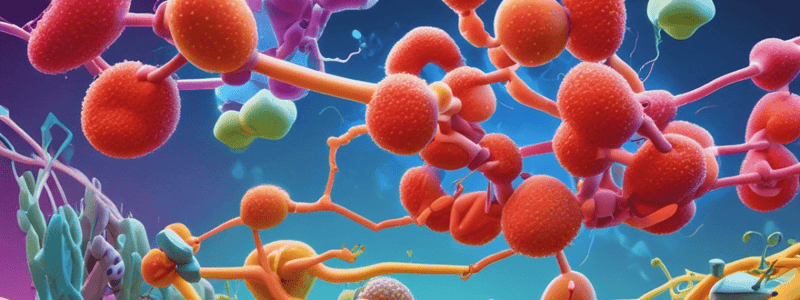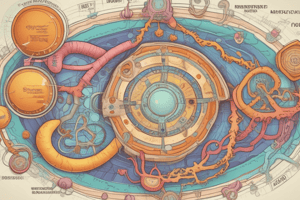Podcast
Questions and Answers
Which one of the following statements is correct regarding the regulation of carbohydrate metabolism?
Which one of the following statements is correct regarding the regulation of carbohydrate metabolism?
What is the primary purpose of the reciprocal regulation between glycolysis and gluconeogenesis?
What is the primary purpose of the reciprocal regulation between glycolysis and gluconeogenesis?
How many of the steps in glycolysis and gluconeogenesis are catalyzed by the same enzymes?
How many of the steps in glycolysis and gluconeogenesis are catalyzed by the same enzymes?
Which enzyme is involved in the conversion of fructose 1,6-bisphosphate to fructose 6-P in gluconeogenesis?
Which enzyme is involved in the conversion of fructose 1,6-bisphosphate to fructose 6-P in gluconeogenesis?
Signup and view all the answers
Which hexokinase isozyme is specific to the liver and responsive to higher glucose levels?
Which hexokinase isozyme is specific to the liver and responsive to higher glucose levels?
Signup and view all the answers
What is the role of hexokinase IV (Glucokinase) in glycolysis?
What is the role of hexokinase IV (Glucokinase) in glycolysis?
Signup and view all the answers
What is a characteristic feature of hexokinase IV (Glucokinase) compared to other hexokinase isozymes?
What is a characteristic feature of hexokinase IV (Glucokinase) compared to other hexokinase isozymes?
Signup and view all the answers
What is the role of Glycogen Synthase Kinase 3 (GSK3) in the regulation of glycogen synthase activity?
What is the role of Glycogen Synthase Kinase 3 (GSK3) in the regulation of glycogen synthase activity?
Signup and view all the answers
How does insulin trigger the activation of glycogen synthase b?
How does insulin trigger the activation of glycogen synthase b?
Signup and view all the answers
How do epinephrine (in muscle) and glucagon (in liver) affect the activity of glycogen synthase?
How do epinephrine (in muscle) and glucagon (in liver) affect the activity of glycogen synthase?
Signup and view all the answers
How does glucose 6-phosphate affect the activity of glycogen synthase?
How does glucose 6-phosphate affect the activity of glycogen synthase?
Signup and view all the answers
How do allosteric and hormonal signals coordinate carbohydrate metabolism globally in the liver?
How do allosteric and hormonal signals coordinate carbohydrate metabolism globally in the liver?
Signup and view all the answers
What is the key difference in the control of carbohydrate metabolism between the liver and other tissues?
What is the key difference in the control of carbohydrate metabolism between the liver and other tissues?
Signup and view all the answers
What is the primary role of insulin in regulating glycolysis and gluconeogenesis?
What is the primary role of insulin in regulating glycolysis and gluconeogenesis?
Signup and view all the answers
Which of the following statements accurately describes the regulation of pyruvate kinase (PK) in glycolysis?
Which of the following statements accurately describes the regulation of pyruvate kinase (PK) in glycolysis?
Signup and view all the answers
What is the feed-forward mechanism that activates pyruvate kinase (PK) during high glycolytic flux?
What is the feed-forward mechanism that activates pyruvate kinase (PK) during high glycolytic flux?
Signup and view all the answers
Which of the following molecules acts as an allosteric inhibitor of pyruvate kinase (PK), indicating an abundant energy supply?
Which of the following molecules acts as an allosteric inhibitor of pyruvate kinase (PK), indicating an abundant energy supply?
Signup and view all the answers
In which tissue(s) is the liver isozyme (L form) of pyruvate kinase (PK) regulated by glucagon?
In which tissue(s) is the liver isozyme (L form) of pyruvate kinase (PK) regulated by glucagon?
Signup and view all the answers
What is the physiological significance of alanine inhibiting pyruvate kinase (PK) activity?
What is the physiological significance of alanine inhibiting pyruvate kinase (PK) activity?
Signup and view all the answers
Which of the following statements is correct regarding the role of insulin in the regulation of glycogen breakdown in the liver?
Which of the following statements is correct regarding the role of insulin in the regulation of glycogen breakdown in the liver?
Signup and view all the answers
Which of the following statements accurately describes the role of glucagon and epinephrine in the regulation of glycogen phosphorylase?
Which of the following statements accurately describes the role of glucagon and epinephrine in the regulation of glycogen phosphorylase?
Signup and view all the answers
Which of the following statements accurately describes the role of glucose as a regulator of glycogen phosphorylase in the liver?
Which of the following statements accurately describes the role of glucose as a regulator of glycogen phosphorylase in the liver?
Signup and view all the answers
Which of the following statements accurately describes the role of ATP and G6P in the regulation of glycogen phosphorylase?
Which of the following statements accurately describes the role of ATP and G6P in the regulation of glycogen phosphorylase?
Signup and view all the answers
Study Notes
Regulation of Carbohydrate Metabolism
- Reciprocal regulation between glycolysis and gluconeogenesis ensures that one pathway is active while the other is suppressed, optimizing energy use.
- Glycolysis and gluconeogenesis share only a few enzymes, meaning most steps are regulated independently.
- Fructose 1,6-bisphosphate converts to fructose 6-phosphate in gluconeogenesis by the enzyme fructose-1,6-bisphosphatase.
- Hexokinase IV, also known as glucokinase, is liver-specific and active at higher glucose concentrations.
- Hexokinase IV has a lower affinity for glucose compared to other hexokinases, allowing it to act primarily when glucose is abundant.
Glycogen Metabolism
- Glycogen Synthase Kinase 3 (GSK3) inhibits glycogen synthase, reducing glycogen synthesis in response to energy needs.
- Insulin activates glycogen synthase b by promoting dephosphorylation, enabling glycogen storage.
- Epinephrine in muscle and glucagon in the liver decrease glycogen synthase activity, promoting glucose release.
- Glucose 6-phosphate enhances glycogen synthase activity by acting as an allosteric regulator.
Coordination of Metabolism
- Allosteric and hormonal signals globally coordinate carbohydrate metabolism in the liver, allowing for responses to changes in energy demand.
- Liver metabolism differs from other tissues in that it can both store and release glucose, adjusting responses based on blood glucose levels.
Insulin and Carbohydrate Regulation
- Insulin plays a primary role in stimulating glycolysis and inhibiting gluconeogenesis, facilitating energy production and storage.
- Pyruvate kinase (PK) regulation is sensitive to energy status, with key enzymes controlling its activity.
- High glycolytic flux activates pyruvate kinase through a feed-forward mechanism, utilizing substrates from previous steps.
- ATP acts as an allosteric inhibitor of pyruvate kinase, signaling a sufficient energy supply.
Specific Enzyme Regulation
- The liver isozyme (L form) of pyruvate kinase is regulated by glucagon, impacting energy metabolism in fasting states.
- Alanine inhibits pyruvate kinase, indicating that protein breakdown is occurring and energy needs are being met.
- Insulin suppresses glycogen breakdown in the liver, promoting energy storage.
- Glucagon and epinephrine promote glycogen phosphorylase activity, enhancing glucose mobilization.
- Glucose acts as a regulator of glycogen phosphorylase in the liver by signaling sufficient glucose availability.
- ATP and glucose 6-phosphate inhibit glycogen phosphorylase, reflecting energy status and storage signals.
Studying That Suits You
Use AI to generate personalized quizzes and flashcards to suit your learning preferences.




